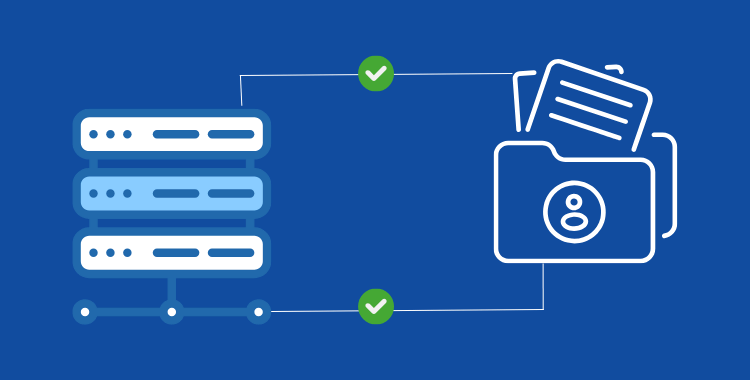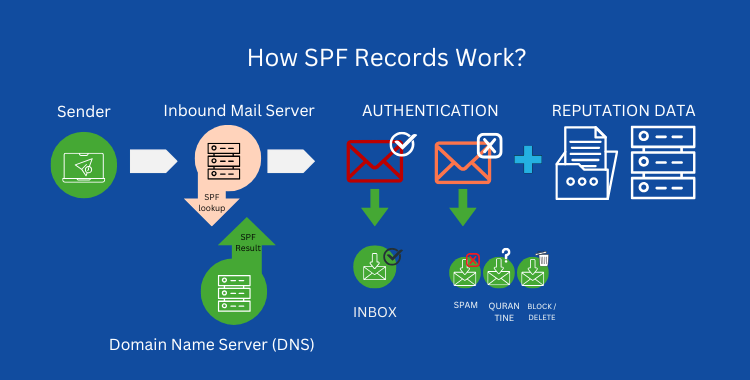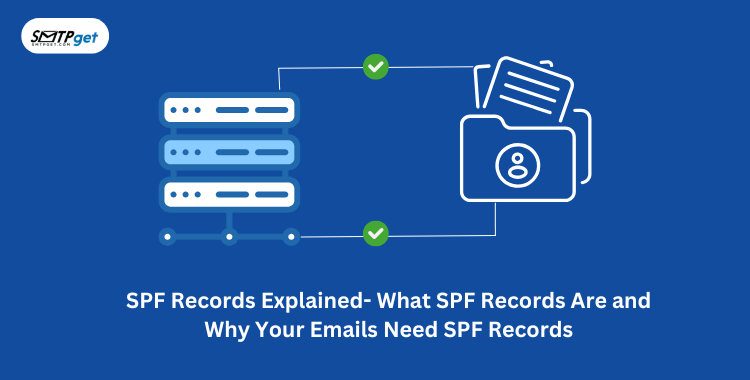Have you ever wondered why some emails end up in spam folders instead of inboxes? One key reason could be missing SPF records. SPF, or Sender Policy Framework, is an important tool for SMTP authentication. It helps ensure that emails from your domain are trustworthy and not fake. In simple terms, SPF records act like a security badge for your emails, showing email servers that the messages are coming from an approved source.

Without proper SPF records, your emails could get flagged as suspicious or even rejected by email providers. This can hurt your email deliverability and damage your reputation. Whether you’re running a business or managing personal emails, understanding SPF records can make a big difference. This blog will explain SPF records, how they work, and why they’re essential for protecting your emails. Let’s dive in and learn how SPF records can keep your emails safe and reliable!
What is SPF record?
SPF, or Sender Policy Framework, is an email authentication method designed to prevent unauthorized users from sending emails on behalf of your domain. It works by specifying which SMTP mail servers are allowed to send emails to your domain. This is achieved through a special entry in your domain’s DNS (Domain Name System) settings called an SPF record.
An SPF record is a simple text file (TXT) that lists the authorized IP addresses or mail servers permitted to send emails to your domain. When an email is sent, the receiving server checks the SPF record of the sender’s domain to confirm that the email came from an approved source. If the sender is not authorized, the email is flagged as suspicious or marked as spam.
SPF records are important for protecting your domain from spoofing and phishing attacks. Spoofing occurs when someone sends fake emails pretending to be you, often for malicious purposes. By implementing SPF records, you help ensure that your emails are trusted and delivered successfully to inboxes. Setting up SPF is straightforward and can significantly improve your email security and deliverability. It’s an essential step for anyone managing emails, whether for personal use or business communication.
How SPF Records Work
SPF (Sender Policy Framework) records are a key part of email authentication, designed to verify if an email is sent from an authorized source. Here’s how they work:

An SPF record is a type of DNS (Domain Name System) entry added to your domain. This record contains a list of IP addresses and servers authorized to send emails on behalf of your domain. When you send an email, the recipient’s bulk email server checks the SPF record to confirm if the sending server is allowed.
Here’s the process in action:
- Email Sent: You send an email from your domain.
- SPF Check: The recipient’s email server checks the SPF record of your domain.
- Validation: If the sending server matches an authorized entry in the SPF record, the email is marked as valid. If not, it may be flagged as spam or rejected.
SPF records are crucial because they help prevent email spoofing—a tactic used by spammers to fake your domain. By implementing SPF records, you improve email deliverability and protect your domain’s reputation. Setting up SPF is a simple yet powerful step to ensure your emails are trusted and secure.
Importance of SPF Records for Email Authentication
SPF Records are essential for protecting your domain and ensuring your emails reach the intended recipients. Below are the key reasons why SPF records are important:
1. Prevents Email Spoofing
SPF records help prevent cybercriminals from sending fake emails using your domain. By specifying authorized bulk email servers, SPF ensures that only trusted sources can send emails on your behalf.
2. Improves Email Deliverability
Without SPF, email servers may treat your messages as spam. Proper SPF records enhance the trustworthiness of your domain, increasing the chances of your emails landing in inboxes instead of spam folders.
3. Protects Your Brand Reputation
Emails sent from your domain reflect your brand. SPF records reduce the risk of fraudulent activities like phishing, which could damage your reputation and harm your customer relationships.
4. Complies with Email Security Standards
Many email providers, including Gmail and Microsoft, prioritize SPF records as part of their security checks. Having SPF ensures compliance with these standards, improving your credibility as a sender.
5. Strengthens Domain Reputation
Bulk Email providers monitor the reputation of sending domains. SPF records signal that your domain follows best practices, strengthening your reputation and maintaining high email engagement rates.
6. Works with Other Authentication Protocols
SPF works alongside DKIM (DomainKeys Identified Mail) and DMARC (Domain-based Message Authentication, Reporting, and Conformance) to provide a powerful email authentication framework. Together, these protocols offer layered protection against email fraud.
7. Simplifies Email Management
By defining authorized servers, SPF simplifies the management of your email-sending practices. This is especially helpful for businesses using multiple third-party tools for email campaigns.
How SPF Records Enhance Email Deliverability
Email deliverability is a critical aspect of online communication, especially for businesses relying on email marketing, transactional messages, or customer outreach. A well-implemented SPF (Sender Policy Framework) record can significantly boost your email deliverability. Here’s how SPF records contribute to better email performance:
1. Protects Against Email Spoofing
SPF records help prevent email spoofing, a common tactic used by cybercriminals to send fraudulent emails pretending to be from your domain. By verifying authorized email servers, SPF ensures that only legitimate emails reach recipients.
2. Improves Trust with Email Providers
Email service providers like Gmail, Outlook, and Yahoo prioritize emails from domains with proper SPF records. It signals that you follow email authentication best practices, making your emails less likely to be flagged as spam.
3. Reduces Spam Complaints
When SPF records are correctly set up, the chances of your emails being marked as spam decrease. This helps maintain a positive email sender reputation, ensuring your future campaigns reach inboxes rather than junk folders.
4. Increases Email Deliverability Rates
SPF records improve your domain’s credibility. This boosts your deliverability rates because email servers trust your emails, knowing they come from authorized sources.
5. Minimizes Risk of Blacklisting
Without SPF records, spam filters may suspect your domain of sending spam or fraudulent emails, leading to blacklisting. A blacklisted domain struggles to deliver emails effectively. SPF reduces this risk by proving the authenticity of your emails.
6. Enhances Customer Engagement
Emails landing in inboxes rather than spam folders are more likely to be opened and read. Better deliverability increases customer engagement with your content, promotions, and updates.
7. Supports DMARC and DKIM Protocols
SPF works alongside other email authentication protocols like DMARC and DKIM. Together, they create a stronger framework for email security and deliverability, providing multiple layers of protection for your domain.
8. Maintains Domain Reputation
A solid domain reputation is crucial for running successful email campaigns. SPF records help you maintain this by ensuring only legitimate emails are sent from your domain, preventing damage from spoofed or spam emails.
9. Improves Analytics Accuracy
SPF records prevent fake emails from being sent on your behalf, which can distort your email analytics. Accurate analytics help you measure the success of your campaigns and optimize them for better results.
10. Simplifies Email Troubleshooting
When emails fail to deliver, troubleshooting can be time-consuming. SPF records reduce delivery issues, saving you time and effort in resolving email-related problems.
Common Misconceptions About SPF Records
SPF (Sender Policy Framework) records are essential for email security, but many people still have misconceptions about how they work. These myths can lead to mistakes in email authentication, affecting email deliverability and security. Let’s clear up some common misconceptions about SPF records.
1. SPF Records Are Only for Spam Prevention
Misconception: Many people think SPF records only help in preventing spam. While SPF records do help in identifying spam, their primary purpose is email authentication. SPF helps ensure that only approved senders can send emails using your domain.
Reality: SPF records are part of a broader email authentication system that also includes DKIM (DomainKeys Identified Mail) and DMARC (Domain-based Message Authentication, Reporting, and Conformance), which collectively protect your domain’s reputation and improve email security.
2. SPF Records Guarantee 100% Email Deliverability
Misconception: Some believe that having an SPF record automatically guarantees that all emails will land in the inbox.
Reality: SPF records improve email deliverability, but they don’t guarantee inbox placement. Other factors, such as email content, sender reputation, and engagement levels, also affect whether an email reaches the inbox.
3. SPF Records Are Only Necessary for Large Companies
Misconception: Many small businesses or individuals believe SPF records are only important for large organizations.
Reality: SPF records are crucial for all email senders, regardless of business size. Without SPF, even personal or small business emails are more likely to be marked as spam. Email authentication protects everyone’s reputation and helps maintain email security.
4. SPF Records Are Only Needed for Outbound Emails
Misconception: Some assume SPF records are only necessary when sending emails to others.
Reality: SPF records also help when receiving emails. They help identify if incoming emails from external sources are legitimate or spoofed. Having an SPF record set up for your domain is crucial for protecting your domain’s reputation both as a sender and a receiver.
5. An SPF Record Should Be a Single Line of Text
Misconception: It’s often thought that a single line of text in the DNS settings is all you need for an SPF record.
Reality: While an SPF record can be a single line, it can be more complex depending on your email setup. Multiple servers and third-party services (e.g., marketing tools or CRM systems) may need to be included in your SPF record. It’s important to ensure that the SPF record includes all authorized email sources.
6. SPF Records Can Be Used to Block All Spam Emails
Misconception: Some people think SPF records can block all spam or unauthorized email.
Reality: SPF records only verify the sender’s IP address. They cannot block spam on their own. To effectively protect against spam and phishing, SPF should be used alongside DKIM and DMARC. These combined mechanisms provide a more robust defense.
7. You Only Need to Set SPF Once and Forget About It
Misconception: Once you set up SPF records, they don’t need to be updated or maintained.
Reality: SPF records require ongoing management. If you add or remove bulk email services, you must update your SPF record accordingly. Failing to update your SPF record can lead to authentication failures, causing legitimate emails to be flagged as spam.
8. Too Many SPF Records Are Fine
Misconception: Some believe that adding multiple SPF records is harmless and can be done without consequence.
Reality: Having multiple SPF records can cause authentication failures. The DNS specification allows only one SPF record per domain, and having more than one can lead to issues with email delivery. Always ensure there is only one SPF record for each domain.
9. SPF Records Don’t Affect Email Open Rates
Misconception: It’s common to think SPF records only affect email delivery and not open rates.
Reality: While SPF records don’t directly influence open rates, emails that pass SPF checks are less likely to be flagged as spam, leading to better engagement. A properly authenticated email has a higher chance of being opened by recipients.
10. SPF Records Alone Are Enough to Prevent Phishing
Misconception: SPF records are often thought to be a sufficient defense against phishing attacks.
Reality: SPF records play a role in preventing phishing, but they are not foolproof. Phishing attacks can still bypass SPF if other security mechanisms like DKIM and DMARC aren’t in place. SPF should be used in combination with these technologies to effectively prevent phishing and email spoofing.
How to Create an SPF Record
Creating an SPF (Sender Policy Framework) record is essential to ensure that your emails are trusted and not marked as spam. Here’s a simple guide on how to create an SPF record:
1. Understand What SPF Records Do
- SPF records help prevent email spoofing by allowing you to specify which SMTP mail servers are authorized to send emails on behalf of your domain.
- They are added to your domain’s DNS settings and can improve email deliverability.
2. Check Your Email Sending Sources
- Before creating an SPF record, identify all the email servers or services you use to send emails (e.g., your web hosting provider, email marketing services like SMTPget, Mailchimp, or a third-party bulk email service).
- This is crucial as the SPF record must include all authorized senders for your domain.
3. Log Into Your Domain’s DNS Management Panel
- To add or edit your SPF record, you need to access your domain’s DNS settings.
- This is usually done through your domain registrar (like GoDaddy, or Namecheap) or web hosting service (like Bluehost or SiteGround).
4. Create the SPF Record Syntax
An SPF record follows a specific syntax. A basic SPF record looks like this:
makefile v=spf1 include:example.com -all
Here’s a breakdown of the syntax:
- v=spf1: This defines the version of SPF you are using (always “spf1”).
- include:: Used to include other domains or services that are allowed to send email on your behalf (e.g., your email service provider’s domain).
- -all: This means only the servers specified in your SPF record are allowed to send emails. Any other server is not authorized and will fail SPF checks.
5. Add the SPF Mechanisms
Depending on your needs, you’ll need to add different mechanisms to the record. Some of the most common mechanisms are:
- ip4:: Allows specific IP addresses to send emails. Example: ip4:192.168.1.1
- include:: Used to include other services. Example: include:spf.mailprovider.com
- a:: Allows the server to send emails if the domain’s A record resolves to the IP address.
- mx:: Allows mail servers listed in your domain’s MX (Mail Exchange) records to send emails.
6. Combine All the Information in One Record
Here’s an example of a complete SPF record:
makefile
v=spf1 ip4:192.168.1.1 include:spf.mailprovider.com mx -all
This example allows emails from the IP address 192.168.1.1, the mail provider spf.mailprovider.com, and any mail server listed in your domain’s MX records.
7. Add the SPF Record to Your DNS Settings
- In your DNS management panel, add a new TXT record with the SPF information.
- The name/host field is usually left blank or set as “@” to apply the record to your root domain.
- Paste the SPF record you created into the “Value” or “Data” field.
8. Verify the SPF Record
- After adding the SPF record, it’s important to verify that it’s working correctly.
- You can use online tools like MXToolbox or SPF Record Checker to test your SPF record.
- These tools will check if your SPF record is set up correctly and whether it’s returning the expected results.
9. Monitor and Update Your SPF Record
- Once your SPF record is live, make sure to monitor its performance and update it whenever you add new email services.
- If you change email providers or add new sending servers, make sure to update your SPF record accordingly to keep your email system secure.
10. Avoid SPF Record Issues
- Keep in mind that an SPF record can only be 255 characters long, and DNS has a limit of 10 lookups per SPF check. Be mindful not to exceed these limits.
- If your SPF record becomes too large or exceeds the lookup limit, consider simplifying it or using the “include” mechanism to point to external SPF records.
SPF Record Syntax and Components
SPF (Sender Policy Framework) records are written in a specific format that helps email servers identify whether an email from your domain is legitimate. Here’s a breakdown of the key components and syntax of an SPF record:
v=spf1
The version of SPF used. “v=spf1” is the most common and indicates the start of the SPF record.
Mechanisms
These define which mail servers are allowed to send emails on behalf of your domain. Common mechanisms include:
- ip4: Specifies allowed IPv4 addresses (e.g., ip4:192.168.0.1).
- ip6: Specifies allowed IPv6 addresses (e.g., ip6:2001:db8::1).
- a: Allows mail servers with the same IP as your domain’s A record (e.g., a or a:mail.example.com).
- mx: Permits mail servers listed in your domain’s MX (Mail Exchange) records (e.g., MX).
- include: References another domain’s SPF record (e.g., include:_spf.google.com).
Qualifiers
Qualifiers indicate how strict the mechanism is:
- + (Pass): Default, email is allowed.
- – (Fail): Email is not allowed.
- ~ (SoftFail): Email is marked as suspicious but still accepted.
- ? (Neutral): No policy applied, email is neither allowed nor rejected.
Modifiers
Modifiers provide additional information or control. Common modifiers include:
all: Specifies how emails from unknown sources should be handled. Typically used at the end (e.g., all).
redirect Points to another SPF record to be used (e.g., redirect=_spf.example.com).
Example of SPF Record
v=spf1 ip4:192.168.0.1 include:_spf.example.com -all
This means emails from IP 192.168.0.1 and those authorized by _spf.example.com are allowed, while others will fail.
Validating Your SPF Record
Here’s how you can validate your SPF record:
Check Your SPF Record Exists
Start by confirming if your domain already has an SPF record. You can do this by checking your domain’s DNS settings or using online tools like MXToolbox. If there is no SPF record, you’ll need to create one to avoid email delivery issues.
Use SPF Validation Tools
Several free tools are available to validate SPF records. Simply enter your domain name, and these tools will check if the SPF record is correctly set up and whether it’s valid.
Popular tools include MXToolbox, Kitterman, and DNSstuff.
Ensure the SPF Record Syntax is Correct
Your SPF record should have the right syntax. It should begin with v=spf1 and include the IP addresses or mail servers authorized to send emails on behalf of your domain.
Common syntax issues include missing “~all” or “-all” at the end, which tells email servers what to do if the email doesn’t pass SPF checks.
Check for SPF Record Length Limits
Ensure that you check the SPF record that your SPF record doesn’t exceed DNS lookup limits. An SPF record can include up to 10 DNS lookups, so be mindful of adding too many include statements or redirects.
Verify With Multiple Email Providers
After validating your SPF record, it’s essential to test it with different email providers like Gmail, Outlook, and Yahoo. Bulk Emailing Service Providers may handle SPF differently, so checking with more than one ensures better compatibility.
Monitor Regularly
SPF records need periodic validation to ensure they remain up-to-date. If your email service provider or sending IP changes, update and check spf record accordingly.
How to Troubleshoot SPF Record Issues
Troubleshooting SPF (Sender Policy Framework) record issues can be tricky, but it’s essential for ensuring your emails are delivered successfully. Here are some key steps to identify and resolve SPF record issues:
Check the SPF Record Syntax
Verify the format of your SPF record to ensure it’s correct. Use SPF record checkers online to check for syntax errors. Ensure that the SPF record starts with v=spf1, which indicates the version of SPF.
Validate the SPF Record for Your Domain
Use an SPF validator tool to check if your domain has a valid SPF record. This helps ensure that your SPF record is publicly visible and accessible.
Ensure Proper DNS Setup
SPF records are saved within the DNS settings of your domain. If your DNS is not properly configured, bulk email servers may not be able to find your SPF record. Double-check that the SPF record is added to your domain’s DNS settings correctly.
Check the SPF Record’s Mechanisms
Review the mechanisms and modifiers in your SPF record. Common mechanisms include ip4, ip6, and include. Make sure they point to the correct IP addresses or trusted senders.
Monitor SPF Record Length
SPF records have a limit of 255 characters per string and 10 DNS lookups. If your SPF record exceeds this limit, it could cause issues with email deliverability. Simplify or split up complex records if necessary.
Check for SPF Record Conflicts
Ensure that there are no conflicting SPF records for your domain. Having multiple SPF records can confuse email servers, resulting in delivery problems.
Review SPF Alignment with DKIM and DMARC
SPF works best when aligned with DKIM (DomainKeys Identified Mail) and DMARC (Domain-based Message Authentication, Reporting, and Conformance). Ensure all three are set up correctly for maximum email security.
SPF Records vs. DKIM and DMARC: Understanding the Differences
SPF?
- SPF (Sender Policy Framework) helps prevent email spoofing by verifying that an email comes from an authorized server.
- It works by allowing the domain owner to specify which IP addresses are allowed to send emails on behalf of their domain.
- When an email is received, the receiving server checks the SPF record to ensure the sending server is legitimate.
DKIM?
- DKIM (DomainKeys Identified Mail) adds a layer of security by using encryption to verify the authenticity of the email’s source.
- DKIM uses a cryptographic signature, added to the email header, which is verified by the receiving mail server using the public key from the sender’s domain.
- It ensures the email’s content hasn’t been altered during transmission.
DMARC?
- DMARC (Domain-based Message Authentication, Reporting, and Conformance) ties SPF and DKIM together to provide a stronger defense against phishing and email spoofing.
- DMARC enables domain owners to define how email servers should handle unauthenticated emails (whether they should be rejected, quarantined, or accepted).
- It also provides reporting features, allowing domain owners to track any email authentication issues.
Key Differences:
- SPF focuses on verifying the sender’s IP address.
- DKIM focuses on verifying the integrity and authenticity of the email’s content.
- DMARC combines SPF and DKIM and defines the policy for handling unauthenticated emails, offering more control over your email reputation.
Why Use All Three?
- Using SPF, DKIM, and DMARC together creates a multi-layered defense against spam, phishing, and spoofing.
- They help ensure that your emails reach the inbox and not the spam folder, while also protecting your brand reputation.
Best Practices for Managing SPF Records
Use a Single SPF Record Per Domain
Always ensure that your domain has only one SPF record. Multiple SPF records can cause conflicts and lead to delivery issues. If you need to add more entries, do so within a single SPF record.
Keep the SPF Record Simple
A simple and concise SPF record reduces the chance of errors. Avoid adding unnecessary domains or IP addresses. Keep it to only the essential sources that send emails on behalf of your domain.
Use the “Include” Mechanism for Third-Party Senders
If you use third-party services like email marketing platforms or CRM tools, use the “include” mechanism in your SPF record. This allows you to authorize those services without adding extra IP addresses manually, making it more efficient.
Limit DNS Lookups
SPF records are subject to a limit of 10 DNS lookups. If you exceed this limit, your SPF record will fail. Optimize your SPF record to stay within this limit by reducing the number of “include” or “redirect” mechanisms.
Regularly Review and Update Your SPF Record
As your email practices and third-party services change, make sure to update your SPF record accordingly. Regular audits help ensure your SPF record remains accurate and functional.
Test Your SPF Record
After creating or updating your SPF record, always test it to ensure it’s working properly. Use online tools to check for syntax errors or issues with the record’s configuration.
Use the “SoftFail” or “Fail” Mechanism Correctly
The “SoftFail” mechanism allows you to flag unapproved emails without outright rejecting them, which can be helpful for troubleshooting. However, “Fail” should be used for a stricter policy to reject unauthorized emails completely.
Monitor Email Deliverability
Keep an eye on your email delivery rates. If you notice a drop in inbox placement, it may indicate an issue with your SPF record or other email authentication mechanisms. Regular monitoring helps you quickly address problems.
SPF Record Limitations: What You Need to Know
SPF records are essential for email security, but they come with certain limitations that you should be aware of. Here are some key points to consider:
Maximum Number of DNS Lookups
SPF records are limited to 10 DNS lookups. This means that if your SPF record includes multiple mechanisms that require DNS lookups (like include, a, mx), you must stay under this limit. Exceeding 10 lookups can cause SPF validation failures, leading to your emails being rejected.
Record Length
SPF records can only be up to 255 characters long. If your SPF record exceeds this length, it will be split across multiple strings. This might make managing and troubleshooting SPF records more difficult.
Lack of Granular Control
SPF provides basic email authentication but doesn’t give you detailed control over specific email sources or individual IP addresses. You can only specify allowed mail servers, which may not always cover more complex email-sending scenarios.
No Protection Against All Types of Spoofing
SPF helps prevent some forms of email spoofing, but it does not protect against all threats. For example, SPF doesn’t check the “From” address in the email header, leaving some forms of phishing attacks unchecked. Using SPF alongside other authentication methods like DKIM and DMARC is crucial for better protection.
Complexity in Maintenance
As your email infrastructure grows, maintaining SPF records can become complex. If you add new third-party services or change email providers, you must update your SPF record accordingly. Failure to do so can lead to deliverability issues.
Over-reliance on SPF
Relying solely on SPF can be risky. It’s important to remember that SPF is just one part of email security, and should be used in combination with other tools for maximum effectiveness.
Tools for SPF Record Management
Managing SPF records is crucial to ensure your emails are authenticated and not marked as spam. Here are some tools that can help you manage SPF records effectively:
MXToolbox
- MXToolbox is a popular online tool that provides comprehensive SPF record checking and management.
- It allows you to validate and troubleshoot SPF records, making sure they are properly set up and working.
- It also offers other email-related tools, like DNS lookup and blacklist check.
SPF Record Generator (by Dmarcian)
- This tool helps create and manage SPF records with ease.
- It offers a user-friendly interface where you can add or modify SPF records and get instant validation.
- Dmarcian also provides tools for DMARC and DKIM management, which work together with SPF to improve email security.
DNSstuff
- DNSstuff provides a set of DNS and email tools, including an SPF record checker.
- It lets you test SPF records for errors and ensures you set them up correctly to avoid email deliverability issues.
- The platform offers both free and premium services for more detailed reporting.
Google Admin Toolbox (CheckMX)
- Google’s Admin Toolbox includes a tool called CheckMX, which checks and verifies SPF records.
- It helps detect issues with email authentication and recommends fixes to ensure your SPF records are functioning properly.
- Ideal for Google Workspace users, it offers insights into email deliverability.
Kitterman SPF Tool
- Many people widely use this tool to validate SPF records.
- Kitterman SPF Tool checks your SPF record and offers a detailed report on any errors or issues.
- It’s perfect for troubleshooting and ensuring your SPF setup is working correctly.
Postmark SPF Generator
- Postmark offers an SPF record generator that is easy to use.
- It helps you create and properly configure the right SPF record for your domain.
- Postmark is also a popular email service provider that integrates with SPF for better email security.








